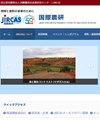Soil Fertility Management and Grassland Renovation on Dairy Farms in Japan: Regional Differences between Hokkaido and Other Prefectures
IF 0.5
4区 农林科学
Q4 AGRICULTURE, MULTIDISCIPLINARY
引用次数: 0
Abstract
In 2015-2016, we investigated the farmland management procedures used on dairy farms in Japan using a mail-back survey. In Hokkaido, 98% of the surveyed farms had meadows, 53% had pastures, and 49% had forage crop fields. In all other prefectures, 19% of farms had meadows, 10% had pastures, and 90% had forage crop fields. The median area of each field category per farm was greater in Hokkaido than in the other prefectures. In all places, the application rate of organic fertilizer decreased in the following order: forage crop field > meadow > pasture (37, 8.7, and 2.7 Mg-manure ha −1 y −1 , respectively, in Hokkaido). In forage crop fields, organic fertilizer was applied at lower rates and inorganic fertilizer was applied at higher rates in Hokkaido than elsewhere (37 vs. 69 Mg-manure ha −1 y −1 and 42 vs. 22 kg-N ha −1 y −1 respectively). In meadows, organic fertilizer was applied at lower rates in Hokkaido (8.7 vs. 14 Mg-manure ha −1 y −1 ); however, inorganic fertilizer was applied at similar rates. The annual rate of grassland renovation with full-inversion tillage in 2006-2010 was 3.0% in Hokkaido and 1.3% in the other prefectures. In both regions, manure was intensively applied during grassland renovation.日本奶牛场土壤肥力管理与草地改造:北海道与其他县的区域差异
2015-2016年,我们采用邮寄调查的方式调查了日本奶牛场的农田管理程序。在北海道,98%的被调查农场有草地,53%有牧场,49%有饲料作物田。在所有其他县中,19%的农场有草地,10%有牧场,90%有饲料农田。北海道每个农场的每一种田类别面积中位数大于其他县。各地区有机肥施用量依次为饲料作物田>草甸>牧场(北海道分别为37、8.7和2.7 mg -粪肥ha - 1 y - 1)。在饲料作物田,北海道的有机肥施用量较低,无机肥施用量较高(分别为37比69 mg -粪肥ha - 1 y - 1和42比22 kg-N ha - 1 y - 1)。北海道草甸有机肥施用量较低(8.7比14 mg / h - 1 y - 1);然而,无机肥料的施用量相似。2006-2010年,北海道全反耕草地年增率为3.0%,其他县为1.3%。这两个地区在草地整治过程中都大量施用有机肥。
本文章由计算机程序翻译,如有差异,请以英文原文为准。
求助全文
约1分钟内获得全文
求助全文
来源期刊
CiteScore
1.00
自引率
25.00%
发文量
42
审稿时长
>36 weeks
期刊介绍:
The Japan Agricultural Research Quarterly (JARQ) is a publication of the Japan International Research Center for Agricultural Sciences (JIRCAS), which provides readers overseas with the latest information on key achievements and developments in agricultural research in Japan, with the expectation that this information would contribute to the agricultural development of countries in tropical and subtropical regions.

 求助内容:
求助内容: 应助结果提醒方式:
应助结果提醒方式:


